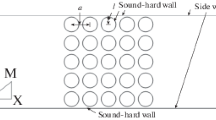Abstract
Acoustic attenuation of a hybrid sonic crystal made with periodic cylindrical scatterers and cascaded porous panels in a broad frequency range is endeavoured in this paper. It is observed via simulations that, the insertion loss (IL) of hybrid configuration is larger than the summation of IL of individual contributors such as periodic scatterers and parallel porous panels in post first Bragg resonance frequency band. The key finding of the research is that the passband in post first Bragg resonance is turning to stopband on introducing the cascaded porous panels within scatterers. Other configurations such as periodic array of cylindrical scatterers in series with porous panels in upstream, downstream and bounded with porous panels are examined and compared. The potential of said claim is shown by investigating a multi-resonant array of scatterers with cascaded porous panels. Finally, the experimental results are presented to authenticate the observed findings of simulations.








Similar content being viewed by others
References
Martínez-Sala, R., Sancho, J., Sánchez, J.V., Gómez, V., Llinares, J., Meseguer, F.: Sound attenuation by sculpture. Nature 378(6554), 241–241 (1995)
Chen, Y.Y., Ye, Z.: Theoretical analysis of acoustic stop bands in two-dimensional periodic scattering arrays. Phys. Rev. E 64(3), 036616 (2001)
Romero-García, V., Sánchez-Pérez, J.V., Garcia-Raffi, L.M.: Tunable wideband bandstop acoustic filter based on two-dimensional multiphysical phenomena periodic systems. J. Appl. Phys. 110(1), 014904 (2011)
Gupta, A.: A review on sonic crystal, its applications and numerical analysis techniques. Acoust. Phys. 60(2), 223–234 (2014)
Kushwaha, M.S.: Stop-bands for periodic metallic rods: sculptures that can filter the noise. Appl. Phys. Lett. 70(24), 3218–3220 (1997)
Liu, Z., Zhang, X., Mao, Y., Zhu, Y.Y., Yang, Z., Chan, C.T., Sheng, P.: Locally resonant sonic materials. Science 289(5485), 1734–1736 (2000)
Montiel, F., Chung, H., Karimi, M., Kessissoglou, N.: An analytical and numerical investigation of acoustic attenuation by a finite sonic crystal. Wave Motion 70, 135–151 (2017)
Elford, D.P., Chalmers, L., Kusmartsev, F.V., Swallowe, G.M.: Matryoshka locally resonant sonic crystal. J. Acoust. Soc. Am. 130(5), 2746–2755 (2011)
Radosz, J.: Acoustic performance of noise barrier based on sonic crystals with resonant elements. Appl. Acoust. 155, 492–499 (2019)
Cavalieri, T., Cebrecos, A., Groby, J.P., Chaufour, C., Romero-García, V.: Three-dimensional multiresonant lossy sonic crystal for broadband acoustic attenuation: application to train noise reduction. Appl. Acoust. 146, 1–8 (2019)
Van der Aa, B., Forssén, J.: Scattering by an array of perforated cylinders with a porous core. J. Acoust. Soc. Am. 136(5), 2370–2380 (2014)
Gulia, P., Gupta, A.: Sound attenuation in triple panel using locally resonant sonic crystal and porous material. Appl. Acoust. 156, 113–119 (2019)
Gulia, P., Gupta, A.: Enhancing the sound transmission loss through acoustic double panel using sonic crystal and porous material. J. Acoust. Soc. Am. 144(3), 1435–1442 (2018)
Jena, D.P., Qiu, X.: Sound transmission loss of porous materials in ducts with embedded periodic scatterers. J. Acoust. Soc. Am. 147(2), 978–983 (2020)
Jena, D.P., Dandsena, J., Jayakumari, V.G.: Demonstration of effective acoustic properties of different configurations of Helmholtz resonators. Appl. Acoust. 155, 371–382 (2019)
Marburg, S., Nolte, B.: Computational Acoustics of Noise Propagation in Fluids: Finite and Boundary Element Methods, vol. 578. Springer, Berlin (2008)
Hakoda, C., Rose, J., Shokouhi, P., Lissenden, C.: (2018). Using Floquet periodicity to easily calculate dispersion curves and wave structures of homogeneous waveguides. In: AIP conference proceedings. AIP Publishing LLC, Vol. 1949, No. 1, p. 020016
Allard, J., Atalla, N.: Propagation of Sound in Porous Media: Modelling Sound Absorbing Materials 2e. Wiley, Hoboken (2009)
Santoni, A., Bonfiglio, P., Fausti, P., Marescotti, C., Mazzanti, V., Mollica, F., Pompoli, F.: Improving the sound absorption performance of sustainable thermal insulation materials: Natural hemp fibres. Appl. Acoust. 150, 279–289 (2019)
Abbad, A., Atalla, N., Ouisse, M., Doutres, O.: Numerical and experimental investigations on the acoustic performances of membraned Helmholtz resonators embedded in a porous matrix. J. Sound Vib. 459, 114873 (2019)
Mohapatra, K., Jena, D.P.: Insertion loss of sonic crystal made with multi resonant shells. Appl. Acoust. 171, 107676 (2021)
Author information
Authors and Affiliations
Corresponding author
Appendix 1: Validation of simulation
Appendix 1: Validation of simulation
In order to validate the simulation results, an array of infinitely periodic cylindrical scatterers is taken from literature for investigation [7]. There are five rows of scatterers, where the diameter of the scatterer is \(d_{2} =\) 0.6 m, lattice constant is \(d_{1}\) = 0.2 m. The calculated IL is shown in Fig. 9a. Next, the melamine foam of 75 mm thickness is modelled using JCA model and validated both calculated and measured results with simulation [20]. The material properties of the foam are taken as (\(\sigma ) =\) 8432 Pa s/m2, porosity \(\left( {{ }\varphi } \right)\) = 0.99, tortuosity \(\left( \alpha \right)\) = 1.02, viscous characteristic length \(\left( {\Lambda } \right)\) = 138e−6 m, thermal characteristic length \(({{\Lambda^{\prime}}}\)) = 154e−6 m. The calculated absorption coefficient is shown in Fig. 9b. From figure, it can be perceived that the suggested simulations are adequate and reliable to examine proposed hybrid sonic crystal which is made with periodic scatterers and porous panels.
Rights and permissions
About this article
Cite this article
Mohapatra, K., Jena, D.P. Acoustic Attenuation of Hybrid Sonic Crystal Made with Periodic Cylindrical Scatterers and Porous Panels. Acoust Aust 49, 441–449 (2021). https://doi.org/10.1007/s40857-021-00239-0
Received:
Accepted:
Published:
Issue Date:
DOI: https://doi.org/10.1007/s40857-021-00239-0





